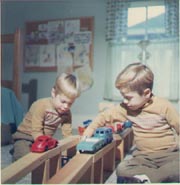|
Total versus Partial Asphyxia, and Protective Biofeedback Mechanisms
The initial experiments in which acute total asphyxia was inflicted produced a Wernicke encephalopathy like pattern of damage, and this was most severe in the inferior colliculus. This result can be compared with the finding of severe damage in the inferior colliculus in cases of extreme thiamine deficiency as reported by Vortmeyer et al. (1992), and damage of the inferior colliculus caused by administration of pyrithiamine to laboratory rats (Chen et al. 1997).
Now knowing that the inferior colliculus has the highest rate of aerobic activity in the brain, it appears paradoxical that this structure should be spared in experiments like those of Myers. The explanation is that protective biofeedback mechanisms go into action when metabolic homeostasis is disturbed. The way hemoglobin delivers oxygen to tissues is an example.
Oxygen in Exchange for Carbon Dioxide
Hemoglobin releases oxygen in exchange for carbon dioxide. Body tissues with the highest metabolic rate produce the most carbon dioxide, and therefore make the greatest demand for delivery of oxygen. This is known as the Bohr effect.
Carbon dioxide produced by the highly active brainstem sensory nuclei should force hemoglobin to give up what little oxygen is available when it is in short supply. The brainstem nuclei will then be spared, but leave nothing to be delivered to the metabolically less active motor centers of the cerebral cortex.
|
|
Brief Total Asphyxia as Part of a Prolonged Period of Oxygen Insufficiency
Brief total asphyxia, as inflicted in Windle's experiments, is far less likely to occur with survival of the infant. But this might be one of the conditions that leads to the core syndrome of autism. Matsuishi et al. (1999) investigated outcome in survivors of a neonatal intensive care unit and diagnosed autistic disorder in 18 of 5,271 infants followed for five years; 57 developed cerebral palsy. Meconium-aspiration syndrome was reported as the most significant factor that distinguished children who developed autistic disorder from those who developed cerebral palsy or who developed normally. A brief period of total asphyxia can easily go unnoticed, however meconium aspiration is a sign that the infant was gasping for air.
A brief period of suffocation would seldom occur without being part of a more prolonged condition that interferes with aerobic metabolism. Could this be why the core syndrome of autism is so rarely seen? Most autistic children show some degree of mental retardation and signs of motor system impairment.
The work of Myers and Windle provides insight on how a spectrum of developmental disorders can occur ranging from motor disability at one end to sensory dysfunction at the other, and why most individual cases will include aspects of both. It seems likely that the Bohr effect is a factor whether the metabolic compromise is due to lack of oxygen, or caused by infection, prenatal exposure to alcohol, or by abnormal metabolites produced in genetic disorders such as phenylketonuria.
|
|
References
Bohr, C., Hasselbalch, K., & Krogh, A. (1904). Ueber einen in biologischer Beziehung wichtigen Einfluss, den die Kohlensaeurespannung des Blutes auf dessen Sauerstoffbindung ubt. Skandinavisches Archiv fur Physiologie, 16, 402-412. [back]
Chen Q, Okada S, Okeda R (1997) Causality of parenchymal and vascular changes in rats with experimental thiamine deficiency encephalopathy. Pathology International 47:748-756. [back]
Landau WM, Freygang WH, Rowland LP, Sokoloff L, Kety SS (1955) The local circulation of the living brain; values in the unanesthetized and anesthetized cat. Transactions of the American Neurological Association 80:125-129.
[back]
Matsuishi, T., Yamashita, Y., Ohtani, Y., Ornitz, E., Kuriya, N., Murakami, Y., Fukuda, S., Hashimoto, T., & Yamashita, F. (1999). Brief report: incidence of and risk factors for autistic disorder in neonatal intensive care unit survivors. Journal of Autism and Developmental Disorders, 29, 161-166. [back]
Myers, R. (1972). Two patterns of perinatal brain damage and their conditions of occurrence. American Journal of Obstetrics and Gynecology, 112, 246-276.
[back]
Windle, W.F. (1969). Brain damage by asphyxia at birth. Scientific American, 221(#4), 76-84.
[back]
Vortmeyer AO, Hagel C, Laas R (1992) Haemorrhagic thiamine deficient encephalopathy following prolonged parenteral nutrition. Journal of Neurology, Neurosurgery and Psychiatry 55:826-829. [back]
|
